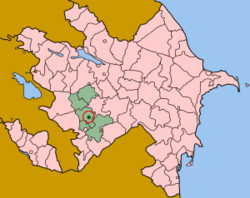| Revision as of 12:01, 3 February 2007 view sourceArtaxiad (talk | contribs)16,771 edits rewrite← Previous edit | Revision as of 12:02, 3 February 2007 view source Artaxiad (talk | contribs)16,771 editsm Added back removed informationNext edit → | ||
| Line 93: | Line 93: | ||
| ==History== | ==History== | ||
| ] | ] | ||
| The settlement was first mentioned in medieval Armenian sources as Vararakn (meaning “rapid creek,” in Armenian). This toponym survived throughout history as one of Stepanakert’s suburbs called Vyrrakna {{citation required}}. The modern city was founded in ] after the ] in place of a village that was called called Khankendi (Khan's village) in ]. In ] it was renamed to Stepanakert, to honor ], an Armenian ] leader from ]. After Azerbaijan declared its independence from the Soviet Union, it was renamed by the Azerbaijani government back to Khankendi as part of a campaign against Communism and of ]{{fact}} of what had been the autononomous ] of Nagorno-Karabakh with a majority Armenian population. Fighting broke out over control of Nagorno-Karabakh which resulted in Armenian control of the region and a connecting corridor to Armenia to the west. There has been an unofficial but observed cease-fire in place since ]. | |||
| ==Economy== | ==Economy== | ||
Revision as of 12:02, 3 February 2007
Place| Stepanakert
ՍտեփանակերտKhankendi (Xankəndi) | |
|---|---|
| Parliament building in Stepanakert.Parliament building in Stepanakert. | |
 Map of Azerbaijan showing the town of Stepanakert within Nagorno-Karabakh. Map of Azerbaijan showing the town of Stepanakert within Nagorno-Karabakh. | |
| Province | Stepanakert (City) |
| Government | |
| • Mayor | Eduard Aghabekian |
| Elevation | 810 m (2,670 ft) |
| Population | |
| • Total | ~40,000 |
Stepanakert (Armenian: Ստեփանակերտ; officially known as Xankəndi in Azerbaijan, transliterated as Khankendi) is the capital city of the Nagorno-Karabakh Republic, a de-facto independent republic which is officially part of Azerbaijan.. The city has a population of about 40,000. As of 2007, Stepanakert, like most of Nagorno-Karabakh, remains under Armenian military control, and most of the local Azerbaijani population has fled the city.
History
The settlement was first mentioned in medieval Armenian sources as Vararakn (meaning “rapid creek,” in Armenian). This toponym survived throughout history as one of Stepanakert’s suburbs called Vyrrakna . The modern city was founded in 1917 after the October revolution in place of a village that was called called Khankendi (Khan's village) in Azerbaijan. In 1923 it was renamed to Stepanakert, to honor Stepan Shahumyan, an Armenian communist leader from Baku. After Azerbaijan declared its independence from the Soviet Union, it was renamed by the Azerbaijani government back to Khankendi as part of a campaign against Communism and of Azerification of what had been the autononomous oblast of Nagorno-Karabakh with a majority Armenian population. Fighting broke out over control of Nagorno-Karabakh which resulted in Armenian control of the region and a connecting corridor to Armenia to the west. There has been an unofficial but observed cease-fire in place since 1994.
Economy

prior to the war, Stepanakert's economy revolved mostly around food processing, silk weaving, and winemaking. After the war, the city's economy was greatly damaged, but in recent years, largely due to the investments of the Armenian Diaspora, economic activity has picked up in Stepanakert.
Buildings and structures
Religious
There is not a traditional church in Stepanakert as of (2007) although most of the population of the city are Christians. The believers attend the church that is in the building of the House of Culture. There is one ancient church in the city that was build in the 18th century, but it is not operating. On September 15, 2006 the foundation stones of St. Jacob Church in Stepanakert were laid. Armenian benefactor Vache Yepremian from Los Angeles is sponsoring the construction of the church. Its construction will probably last for 2-3 years.
It is also the home of the Artsakh State Museum.
Sister cities
 Montebello, California, USA (2005)
Montebello, California, USA (2005)
References
- 1993 UN Security Council Resolutions on Nagorno-Karabakh, US State Department, accessed February 1, 2007 http://www.state.gov/p/eur/rls/or/13508.htm
External links
- Nagorno-Karabakh Nagorno-Karabakh's website
- Karabakh’s Election Conundrum November 2005 article about elections for seats in the Milli Mejlis (Azerbaijani parliament) for Azeri refugees
- Stepanakert Armeniapedia atricle
| Administrative divisions of Artsakh | ||
|---|---|---|
| Capital city | ||
| Provinces | ||
| Provincial capitals | ||
| Other urban communities |
| |